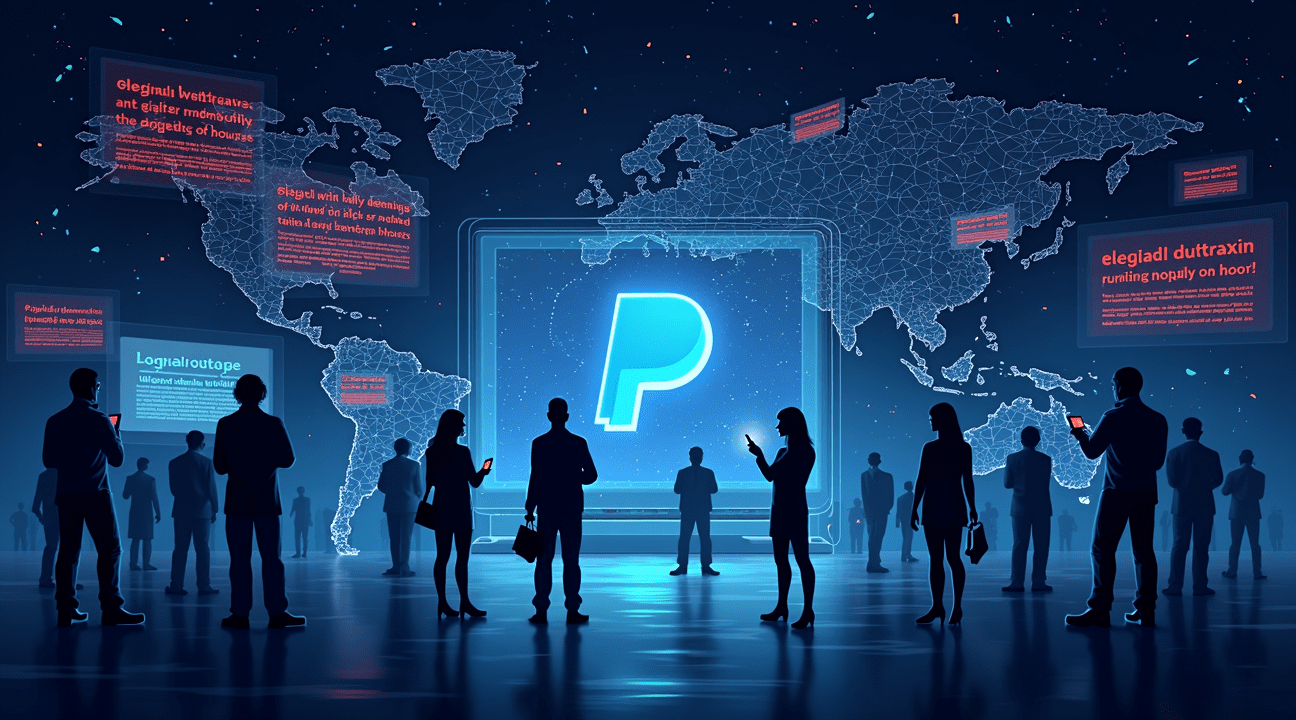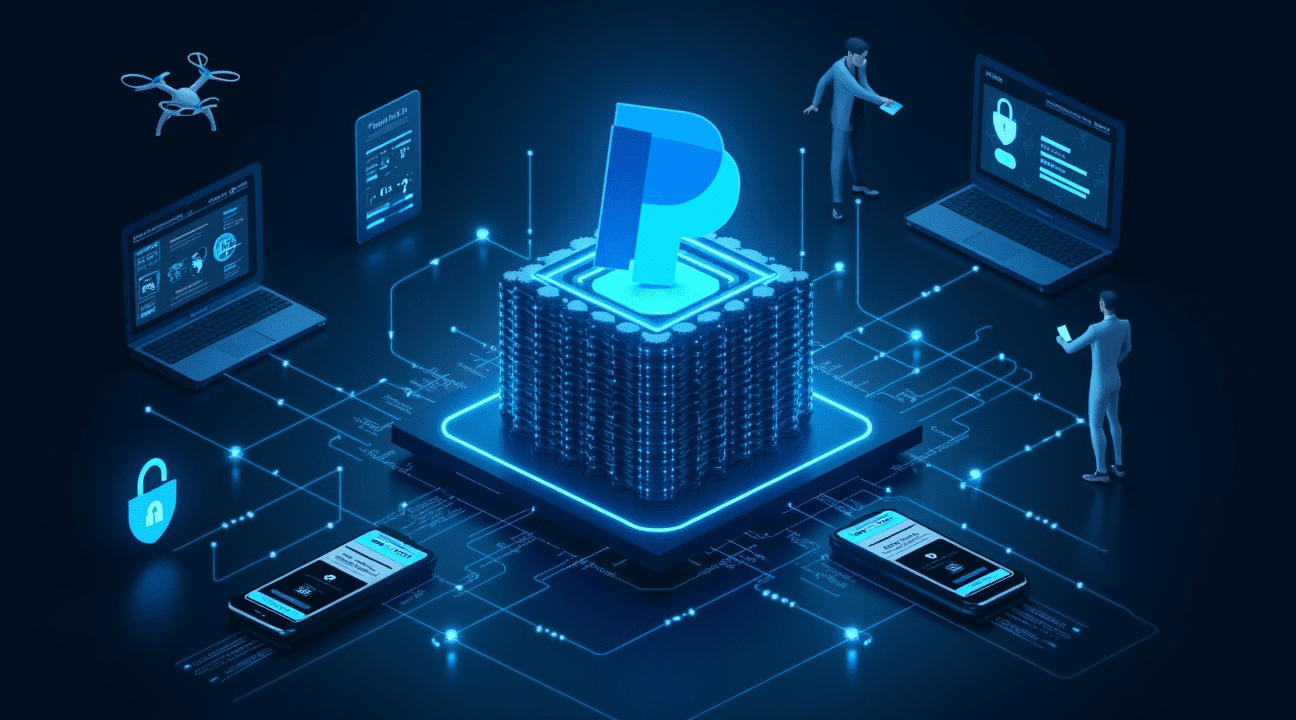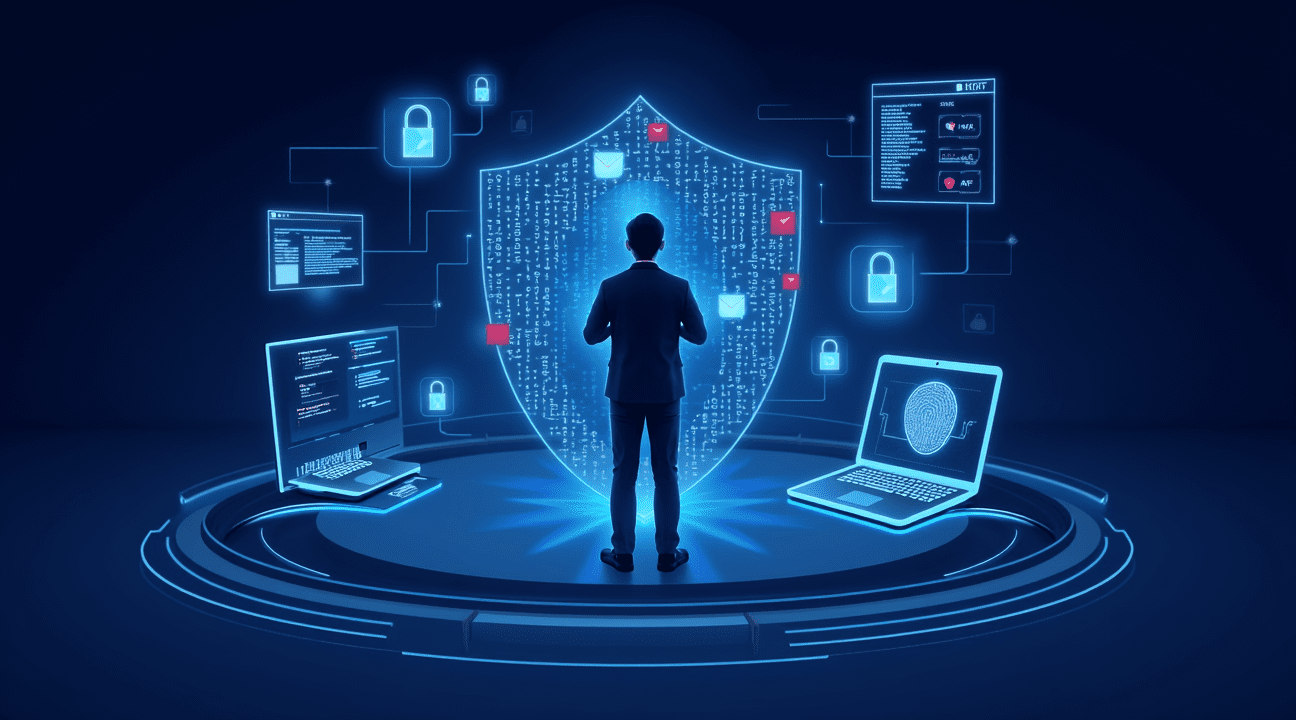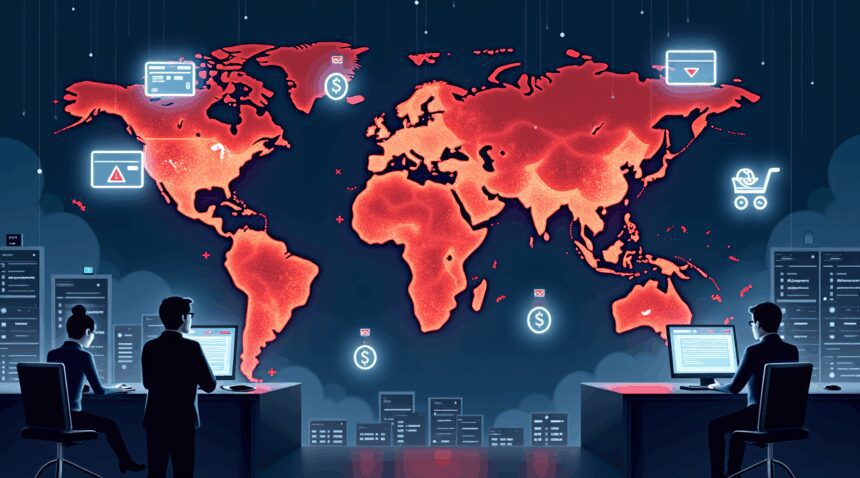PayPal encountered a major two-hour global disruption on November 21, 2024, impacting over 8,735 users during the critical holiday shopping season when the platform handles up to $1 billion in daily transactions.
Understanding the PayPal Outage
The recent PayPal service interruption highlighted the vulnerabilities digital payment systems face during peak usage. Historically, such failures occur most often during high-traffic times like Black Friday and during scheduled maintenance. As PayPal processes a massive volume of transactions daily, disruptions can ripple across global e-commerce.
When Are Disruptions Most Likely?
PayPal handles around 41 million transactions per day, leading to increased strain on infrastructure, especially during holiday shopping spikes. When transactions exceed $1 billion in a day, server load and network capacity can reach critical thresholds, triggering potential outages.
Protecting Your Finances During Payment Platform Outages
Best Practices for Security
- Activate two-factor authentication to provide an extra layer of protection against unauthorized logins and mitigate rising phishing threats.
- Change your password every 90 days to stay ahead of zero-day vulnerabilities, which have increased by 55% in recent years.
- Monitor your account weekly for unusual activity, and report any suspicious transactions within 24 hours to maximize PayPal’s fraud protection coverage.
Backup Funds Strategy
- Keep multiple payment methods linked (such as a bank account and an alternate credit card) to ensure continued access to funds during PayPal outages.
- Maintain an emergency cash reserve as unexpected longer outages can restrict both withdrawals and crypto transactions.
If Your Account Is Compromised
- Contact PayPal support immediately to initiate a recovery process.
- Document all unusual transactions using screenshots for future reference or dispute resolution.
- Alert linked banks or financial institutions about the incident to prevent the spread of possible breaches.
More Resources
To stay informed and prepared during online financial disruptions, consider reviewing the official PayPal Help Center for real-time updates and security tips.
PayPal’s Two-Hour Global Meltdown: What 8,735 Users Experienced on November 21, 2024
I witnessed firsthand how PayPal’s infrastructure buckled under pressure on November 21, 2024, when a major global outage disrupted services for approximately two hours. Downdetector recorded a peak of 8,735 user-reported problems during this incident, affecting core services including withdrawals, express checkout, cryptocurrency transactions, Xoom, and Venmo.
PayPal processes about 41 million transactions daily as of 2023, making any system disruption particularly impactful for users worldwide. The November outage occurred during a critical period when transaction volumes surge dramatically. Black Friday and holiday shopping seasons can push PayPal’s daily transaction values beyond $1 billion, creating enormous stress on the platform’s infrastructure.
Understanding PayPal’s Infrastructure Limitations
These massive transaction surges directly increase the likelihood of technical glitches and system failures. PayPal’s servers face extraordinary demands during peak shopping periods, leading to bottlenecks that can cascade into widespread outages. The November 21st incident wasn’t an isolated event—routine maintenance activities have also caused significant disruptions, such as the June 12 maintenance event that lasted up to three hours.
During the two-hour meltdown, users couldn’t complete basic financial tasks that many depend on for daily business operations. Small business owners found themselves unable to process customer payments, while individuals couldn’t access funds or complete urgent transactions. The cryptocurrency trading feature, which has become increasingly popular among PayPal users, remained completely unavailable during the outage.
PayPal typically maintains transparency during these incidents through its official status page, providing real-time updates about service disruptions. The company also sends direct notifications to affected users, though these messages often arrive after users have already discovered problems independently. I’ve observed that PayPal’s communication during outages has improved over recent years, with more frequent updates and clearer explanations of affected services.
The November incident highlights PayPal’s vulnerability during high-traffic periods. While the platform handles routine transactions efficiently most days, seasonal spikes and promotional events like Black Friday create perfect storm conditions for system failures. Users can’t predict when these outages will occur, making it essential to have backup payment methods available.
PayPal’s infrastructure continues to evolve to handle increasing transaction volumes, but the November 21st outage demonstrates that even well-established financial platforms aren’t immune to technical failures. The combination of holiday shopping momentum and the platform’s massive daily transaction load created conditions that overwhelmed system capacity.
Recovery from the November outage was relatively swift compared to some previous incidents. PayPal’s engineering teams worked to restore services systematically, bringing different features back online in phases rather than attempting simultaneous restoration of all affected services. This approach helped prevent additional complications that might have extended the downtime further.
The 8,735 reported problems likely represent only a fraction of actual affected users, since many people don’t report issues to tracking services like Downdetector. The real impact probably affected hundreds of thousands of users across PayPal’s various services and geographic regions. Such widespread disruptions underscore why diversifying payment options and maintaining emergency cash reserves remain crucial strategies for both businesses and individual users who rely heavily on digital payment platforms.

The Real Security Threats Targeting Your PayPal Account Right Now
PayPal users encounter several sophisticated threats that continuously evolve to exploit both technical vulnerabilities and human behavior. Phishing attacks represent one of the most pervasive dangers, with cybercriminals crafting convincing fraudulent emails that mirror official PayPal correspondence. These messages typically direct users to fake login pages that capture credentials and financial information. I’ve observed how these scams have become increasingly sophisticated, often including official-looking logos and urgent language about account suspension or verification requirements.
Automated fraud detection systems create another layer of concern for legitimate users. These algorithms sometimes misinterpret normal transactions as suspicious activity, resulting in unexpected account freezes that can trap funds for weeks. Long-term users aren’t immune to these false positives, which can occur when transaction patterns suddenly change or when large amounts are processed within short timeframes.
Account security weaknesses often stem from user behavior rather than platform failures. Weak passwords remain a significant vulnerability, especially when combined with the failure to enable two-factor authentication. Many users underestimate how easily automated tools can crack simple passwords, leaving their accounts exposed to unauthorized access.
The Growing Zero-Day Threat Landscape
Zero-day cyberattacks have emerged as an increasingly serious concern for all digital payment platforms. These attacks exploit previously unknown vulnerabilities before security patches can be developed and deployed. The statistics reveal a troubling trend:
- 83 zero-day attacks were reported in 2021
- This represents a 55% increase compared to 2020
- 42% of all cyberattacks in 2021 involved zero-day vulnerabilities
This type of threat particularly challenges traditional security measures because it exploits vulnerabilities that even the most prepared organizations don’t know exist. PayPal, like other major financial platforms, must constantly monitor for unusual patterns and behaviors that might indicate such attacks are in progress. While users can’t directly defend against zero-day exploits, maintaining strong account security practices helps minimize the potential damage if such an attack succeeds.
The interconnected nature of financial technology means that threats affecting one platform can quickly spread to others. I recommend that users stay vigilant about unusual account activity and report any suspicious behavior immediately, as early detection often proves crucial in limiting the impact of sophisticated attacks.
https://www.youtube.com/watch?v=rtGHs25d3_k
How PayPal’s Security Arsenal Protects Your Money Behind the Scenes
I’ve watched PayPal evolve over the years, and the platform’s security framework operates like a digital fortress with multiple defensive layers working simultaneously. The company doesn’t rely on a single security measure but instead deploys an interconnected system designed to protect your financial data at every possible vulnerability point.
Multi-Layered Protection Systems
PayPal’s security begins the moment you interact with their platform through end-to-end encryption. Every piece of data gets encrypted before it leaves your device and stays protected during transmission to PayPal’s servers. This means even if someone intercepts your data during transmission, they’ll only see scrambled, unusable information.
The platform strengthens access protection through the PayPal Security Key, which provides two-factor authentication. Users must enter a one-time code alongside their password, creating an additional barrier that makes unauthorized access nearly impossible. I’ve found this feature particularly effective since it eliminates the risk of someone accessing your account with just a stolen password.
Continuous monitoring represents another critical defense layer where PayPal employs advanced algorithms and real-time anomaly detection systems. These systems work around the clock, analyzing transaction patterns and flagging suspicious behavior instantly. The platform can detect unusual spending patterns, logins from unfamiliar locations, or attempts to access accounts outside normal user behavior.
PayPal maintains full compliance with PCI-DSS standards and collaborates with Visa and Mastercard’s security initiatives. Regular independent third-party security audits verify the effectiveness of these protective measures. These audits provide an external validation that PayPal’s security protocols meet industry standards and can withstand sophisticated attack attempts.
The technical infrastructure relies on 128-bit SSL encryption, which creates a secure tunnel between your device and PayPal’s servers. This encryption standard ensures that sensitive information like credit card numbers, bank account details, and personal data remains protected during every transaction. E-commerce partnerships often require this level of security to maintain consumer trust and regulatory compliance.
Transaction monitoring extends beyond automated systems to include immediate notification protocols. PayPal sends email alerts for each transaction, allowing users to quickly identify unauthorized activity. I appreciate this feature because it enables rapid response to potential security breaches, minimizing potential financial loss.
PayPal’s security architecture also includes behavioral analysis that learns your typical usage patterns. The system recognizes your usual transaction amounts, preferred merchants, and typical login times. When activities deviate significantly from these established patterns, the platform triggers additional verification steps or temporarily restricts account access until identity confirmation occurs.
The company’s partnerships with major financial institutions provide additional security benefits through shared threat intelligence. When suspicious activity patterns emerge across multiple platforms, PayPal can preemptively protect users before threats reach their accounts. Award-winning security measures often result from this collaborative approach to digital protection.
Account recovery systems include multiple verification methods to ensure legitimate users can regain access while preventing unauthorized individuals from exploiting recovery processes. PayPal requires various forms of identity verification, including security questions, phone verification, and sometimes documentation review for account recovery.
Regular security updates and patches address newly discovered vulnerabilities before they can be exploited. PayPal’s security team continuously monitors emerging threats and adjusts protective measures accordingly. This proactive approach ensures that protection evolves alongside changing cybersecurity landscapes.
The platform’s fraud protection policies provide additional peace of mind through buyer and seller protection programs. These policies cover unauthorized transactions and provide dispute resolution mechanisms when security breaches occur despite protective measures.

Your Personal PayPal Security Checklist: 6 Actions to Lock Down Your Funds
Building a fortress around your PayPal account requires deliberate action on multiple fronts. I’ve compiled six essential steps that can dramatically reduce your vulnerability to security breaches and unauthorized access.
Password Protection and Authentication Upgrades
Start by crafting passwords that would challenge even the most determined attackers. Avoid obvious choices like family names, birthdates, or sequential numbers that hackers can easily guess through social engineering. Instead, combine uppercase letters, lowercase letters, numbers, and special characters in unpredictable patterns.
Update your credentials every 90 days to stay ahead of potential breaches. This practice limits the window of opportunity if your information gets compromised through data leaks or security incidents beyond your control.
Activate PayPal’s two-factor authentication immediately. Choose either the Security Key option or device-based passkeys that utilize biometric scanners, PINs, or passcodes. These additional layers transform a simple password breach into a nearly impossible account takeover.
Active Monitoring and Safe Browsing Practices
- Check your account activity weekly: Review transaction logs for any charges you don’t recognize, no matter how small. Fraudsters often test accounts with minimal amounts before attempting larger thefts.
- Report suspicious activity promptly: Report anything unusual within 24 hours of discovery. PayPal’s fraud protection policies work best when you act quickly, and delayed reporting can complicate recovery efforts.
- Learn to recognize phishing attempts: Scammers craft convincing emails that mimic PayPal’s official communications. Never click login links from emails. Instead, type PayPal’s URL directly into your browser or use bookmarked shortcuts.
- Secure your connection: Use HTTPS encrypted pages (look for a lock icon in the browser address bar). When using public Wi-Fi, consider a VPN to encrypt your data.
- Keep devices updated: Ensure all your connected devices and browsers have the latest patches. Outdated software can create dangerous vulnerabilities that cybercriminals exploit.
These six actions work together to create multiple barriers against potential threats. While streaming platforms expand their security measures for user protection, PayPal users must take personal responsibility for their financial safety. Each security layer you implement makes your account exponentially harder to compromise.

When PayPal Glitches Strike: Understanding Outage Patterns and Transaction Load Impact
PayPal’s massive infrastructure handles an impressive 41 million transactions daily under normal circumstances. This baseline volume creates consistent system stress that the platform manages through sophisticated load balancing and server optimization. However, this enormous daily workload becomes even more challenging when external factors amplify transaction demands.
Shopping holidays and major promotional events represent the most significant threat to PayPal’s system stability. During these peak periods, daily transaction values frequently reach or exceed $1 billion, creating unprecedented strain on the platform’s servers and processing capabilities. Black Friday, Cyber Monday, and holiday shopping seasons consistently push PayPal’s infrastructure to its limits, often resulting in slowdowns or temporary outages that affect millions of users simultaneously.
System Monitoring and Maintenance-Related Disruptions
Scheduled maintenance and system updates also contribute to service interruptions, though these typically last several hours and occur during off-peak times. PayPal announces most planned maintenance windows in advance, but emergency patches and security updates sometimes require immediate implementation without prior notice.
The company employs real-time monitoring tools that constantly evaluate system performance across all services. These systems track payment processing, withdrawal operations, cryptocurrency trading functionality, and integrations with connected platforms like Venmo. When monitoring systems detect anomalies or performance degradation, automatic failsafes activate to prevent complete system failures.
Downdetector serves as a valuable public resource for users experiencing PayPal issues. This independent platform aggregates user reports and provides real-time insights into outage severity and geographic impact. I often check Downdetector when experiencing payment delays to determine whether issues stem from widespread system problems or individual account complications.
Transaction spikes don’t just affect payment processing speed. They can trigger:
- False fraud alerts
- Temporary account limitations
- Delayed fund transfers between accounts
During high-volume periods, PayPal’s security algorithms become more sensitive, sometimes flagging legitimate transactions as suspicious. Record low performance during peak times often correlates with increased customer service complaints and account access issues.
Understanding these patterns helps users anticipate potential disruptions and plan accordingly. Major shopping events consistently strain digital payment systems, making it wise to:
- Complete important transactions before peak shopping periods begin
- Keep alternative payment methods readily available as backup options
These proactive measures help mitigate the impact of any technical difficulties or processing delays experienced on the PayPal platform during high-stress periods.
What to Do When Your PayPal Account Gets Compromised or Frozen
Account compromises and frozen PayPal accounts can happen without warning, creating immediate stress about accessing funds and maintaining financial security. Quick response becomes essential when suspicious activity appears or when PayPal restricts account access.
Immediate Response Steps
Taking swift action protects both current funds and future financial security. I recommend following these critical steps:
- Contact PayPal customer support immediately through their official website or phone line
- Document all suspicious transactions with screenshots and detailed notes
- Change password and security questions if account access remains available
- Review linked bank accounts and credit cards for unauthorized activity
- Notify connected financial institutions about the potential security breach
- File a report with local authorities if significant fraud occurred
Reporting unauthorized transactions requires specific information that helps PayPal’s investigation team work efficiently. Users should gather transaction IDs, dates, amounts, and any communication received from suspicious parties. PayPal’s support team responds faster when provided with comprehensive documentation from the start.
The account recovery process typically begins with email verification, followed by identity confirmation steps. PayPal may request government-issued identification, utility bills showing current address, or bank statements proving ownership of linked accounts. Documentation requirements vary based on the severity of the compromise and the account’s transaction history.
Users often need to provide transaction records spanning several months to verify legitimate account activity. PayPal compares this information against their internal records to confirm account ownership. Entertainment companies and other businesses frequently face similar verification challenges when dealing with payment processor security measures.
Expected resolution timelines depend heavily on case complexity and documentation completeness. Simple password resets may resolve within 24-48 hours, while comprehensive fraud investigations can extend over several days or weeks. PayPal prioritizes cases involving significant financial losses or clear evidence of criminal activity.
Complex cases requiring extensive investigation may involve coordination with law enforcement agencies. These situations often arise when sophisticated fraud schemes target multiple accounts or when large sums are involved. Users should maintain patience during extended investigations while continuing to monitor their other financial accounts for related suspicious activity.
Prevention Strategies to Reduce Risk
Prevention strategies significantly reduce future compromise risks. Two-factor authentication adds an extra security layer that makes unauthorized access considerably more difficult. Regular password updates, preferably every 90 days, help maintain account security against evolving threats.
Backup authentication methods provide alternative access routes when primary methods fail. PayPal allows users to register multiple phone numbers and email addresses for verification purposes. Having current backup options prevents extended lockouts during security incidents.
Security practices extend beyond PayPal itself to include connected devices and networks. Using PayPal only on secure, private internet connections reduces exposure to data interception. Avoiding public WiFi for financial transactions eliminates many common attack vectors used by cybercriminals.
Regular account monitoring helps identify suspicious activity before it escalates into major problems. Checking transaction history weekly allows users to spot unauthorized charges quickly. Setting up account alerts for transactions above certain amounts provides real-time notifications of potentially fraudulent activity.
Keeping contact information updated ensures PayPal can reach users immediately when security concerns arise. Outdated phone numbers or email addresses can delay important security notifications, potentially allowing fraudulent activity to continue longer than necessary. Regular verification of contact details maintains this crucial communication channel.
Account recovery becomes significantly easier when users maintain organized financial records. Keeping digital copies of important documents in secure cloud storage provides quick access during verification processes. This preparation reduces recovery time and demonstrates legitimate account ownership to PayPal’s security team.

Sources:
PYMNTS – “PayPal Resolves 2-Hour Global Outage Affecting Multiple Products”
Security.org – “PayPal Safety”
PayCompass – “PayPal Statistics”
Alphacomm – “Navigating PayPal Fraud Prevention Measures”
PayPal – PayPal Status Page
Synder – “Is PayPal Safe?”
Purplesec – Cyber Security Statistics
PayPal – “PayPal Safety and Security”


